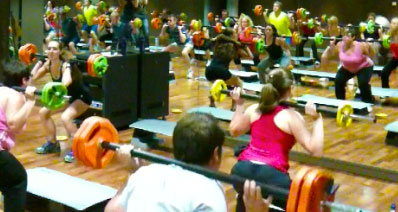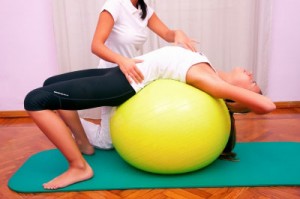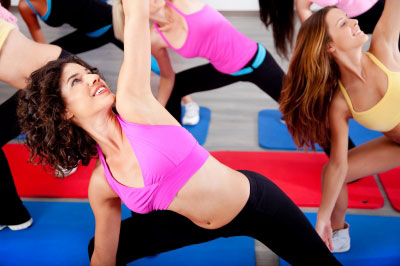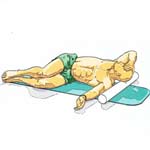Have you asked yourself or your group fitness instructor “how many times should I go to the gym to lose weight or get stronger”?
I often get asked “how many classes do you teach a week?”. I suspect that the idea is to copy the amount of classes I teach in the hope that it will speed up getting stronger or achieving weight loss results.
We fitness instructors exercise for a living and doing so is neither health promoting, nor does it help us get in shape; in fact it actually hinders the body from adapting to the work load because we have the same exact routine/ class schedule every week. Often we do not get enough rest and recovery days.
Instructors need to take the classes that they can get so we can not plan a nice alternation between a hard days and a easy recovery or mind body days.
If I could schedule my workouts freely my routine would be very different, I would be able to train my body effectively rather than just use it.
You as a participant have the opportunity to plan out your own gym schedule from the time table your gym provides. I will explain how I would go about choosing which classes to do on each day of the week and what kind of rules you should bear in mind when doing the planning to get the most out of working out. After all non of us have endless amount of time to spend in the gym or patience to endure not getting results as soon as possible.
I am going to use the current sumer time table from The Edge gym of the Leeds university as an example.

Let’s have two different case studies, one where you are working a 9-5 job which only allows you to exercise before or after work. The other case is based on a student that may be working a part time job so would be able to attend day time classes. Both case studies are currently exercising regularly.
My first question is: what are you doing now? Is your current workout routine working for you or have you been stuck for a while?
Are you exercising safely or do you feel you could do with some help when it comes to exercise execution? For any exercise to be effective in your quest to reach your dream body you need to execute it with great technique to get best muscle activation = better calorie burning and an injury free body that will let you keep working toward your goals without having to take injury breaks that set you back. Slow and steady wins the race, right?
The rules:
- set achievable long term goals i.e. squat 30kg in Body Pump in 3month time or be able to execute all kicks well in Body Combat (I think achievement/ skill goals are a better way to get you to your physical dream body than saying I want to lose X amount in X time – weight loss goals usually cause frustration and demotivation, it is easier to be in charge of what you can influence than to try and influence body weight)
- set attainable goals for every session with a view towards your long term goal i.e. today I will improve my dead lift posture or I will not take a break when it gets a little bit hard work
- stick to scheduled training sessions unless you feel too sore or exhausted to give a better performance than you did the previous time. (read the over training posts I have put out)
- keep note of any aches and pains, fatigue levels or performance fluctuations that are affecting your training – this will give you a good idea wether your schedule plan is working for you. If you are recovered, you should be able to beat your previous performance every time
- always take part in the warm up and cool down to avoid injury (i.e. don’t turn up late)
- lower weights or exercise class volume if you have taken time off due to injury or holiday – build weights and volume of classes back up gradually if you do not want to take additional time off through re-injury
- when weightlifting, choose weights that allow full range of motion and excellent execution – if you are unsure ask your instructor for guidance
- weight lifting: only increase training frequency when you no longer feel improvements in strength – do this gradually while listening to your body
- include variety of strength, cardio and mind/ body sessions for a successful balanced health promoting schedule
- change your schedule at least every 4 weeks
- increase the weight you lift regularly, when you hit the limit in Body Pump (there is one due to the repetitions and what fits on the bar) change to another form of weight lifting such as olympic weight lifting or circuit training for a while before going back to see what you can do in Pump and how your body responds this time round.
A good workout routine will not stress the body to the point of constant exhaustion, but stimulate it to adapt and get stronger.
The 9-5 person:
| Week day | Time/ Class | My top tips for a successful class |
| Monday | 17:45-18:45 Body Pump | Ensure you arrive on time, get a set of every size plate clips and a bar, load on your warm up weight – never more then 5kg each side! Listen carefully to the alignment cues the instructor gives, check your self in the mirror, turn side on to check back alignment at least once per session. With this type of class, do not hold back, lift as much as you safely can in each track. Pay attention to which muscles are working in each track, can you feel it? If you are unsure about anything ask the instructor – we want you to succeed. |
| Tuesday | 17:00-17:45 Pilates | Ensure you are not feeling any pain at any point. Try not to force your lower back into the floor when bracing. Bracing is engaging the abdominal muscles rather than sucking them in. If the class spends more time working the front of the body than it does the back, take additional 5min on the gym floor to train your back if you want to ensure you will not train yourself towards a flexion back pain – read the article why I do not teach crunches. |
| Wednesday | 17:30-18:30 Zumba | Ideally you would have had a weight lifting class today but there is none on at the times you can go. Have some fun wiggling in Zumba. |
| Thursday | 18:45-19:30 Body Pump | I hope you have recovered from Mondays session, if you are still sore you should take a day off or go for an easy swim. |
| Friday | 16:45-17:30 Yoga | You should never feel pain in a Yoga class. Listen carefully to the instructors information, ask for help if you are unsure about your position. Use this session to listen to your body and take note of areas that might need more stretching or mobility work. Yoga is a mind body session where you should be able to breathe deep and even throughout- the body should not feel stressed by this – walk out refreshed. |
| Saturday | 11:30-12:45 Keiser Cycle | Have a light breakfast, read the workout food post. Bring a towel and lots of water. Ensure you have your bike set up correctly and position the ball of your foot on the middle of the pedal, ask for help. Use a push motion as well as a pull motion to train both the front and the back of the leg. |
| Sunday | You and your body deserve a day off. | Do something fun, it can involve movement but should not feel hard work or make you breathless for hours. If you are very desperate to go to the gym to have some company try some Aqua Aerobics. |
Tip: any exercises targeting the major large muscle groups promote weight loss.

The Student/ part timer:
| Week day | Time/ Class | My top tips for a successful class |
| Monday | 15:00-15:45 Fit Ball | Ensure you arrive on time, get a fit ball that is right for your hight. Fit ball exercises are usually challenging for the core, coordination and balance. If you are unsure about anything ask the instructor – we want you to succeed. |
| Tuesday | 11:00-12:00 Body Pump | Ensure you arrive on time, get a set of every size plate clips and a bar, load on your warm up weight – never more then 5kg each side! Listen carefully to the alignment cues the instructor gives, check your self in the mirror, turn side on to check back alignment at least once per session. For this class to be effective don’t hold back, lift as much as you safely can in each track. Pay attention to which muscles are working in each track, can you feel it? If you are unsure about anything ask the instructor – again, we want you to succeed. |
| Wednesday | 14:00-14:45 Yoga | Good mobility is key for great weight lifting. You should never feel pain in a Yoga class. Listen carefully to the instructors information, ask for help if you are unsure about your position. Use this session to listen to your body and take note of areas that might need more stretching or mobility work. Yoga is a mind body session where you should be able to breathe deep and even throughout- the body should not feel stressed by this – walk out refreshed. Good mobility is key for great weight lifting. |
| Thursday | 12:00-13:00 Body Combat | Get your heart rate up and practice your punches. Body Combat is great for having some fun and working on punch and kick skills. There is always nice leg conditioning in there – watch out for track 4 + 6. |
| Friday | 13:30-14:15 Pilates | Ensure you are not feeling any pain at any point. Try not to force your lower back into the floor when bracing. Bracing is engaging the abdominal muscles rather than sucking them in. If the class spends more time working the front of the body than it does the back, take an additional 5min on the gym floor to train your back if you want to ensure you will not train yourself towards a flexion back pain – read the article why I do not teach crunches. |
| Saturday | 12:50-13:50 Body Pump | Have a light breakfast, read the workout food post. I hope you have recovered from Tuesdays session, if you are still sore you should take a day off or go for an easy swim. |
| Sunday | You and your body deserve a day off. | Do something fun, it can involve movement but should not feel hard work or make you breathless for hours. |
If you are a total beginner when it come to attending gym classes regularly start with just 2 classes a week and build up based on the information in my over training self monitoring guidelines. Set yourself up for success – don’t be overzealous.
So you can see I have scheduled 2 weight lifting classes in both plans; weight lifting is very effective at shaping the body, building lean muscle tissue which in turn uses more energy to sustain itself when you are not exercising.
Pilates and Yoga are following a hard day training to let the body recuperate and adapt. If you are desperate to move, then walk – walk as much as you like as long as you do not get out of breath or have to open your mouth to breathe.
Breathing through the mouth triggers a stress response in the body – it thinks you are in danger running away, fighting for your life.
Constant regular stress, be it physical from pain or exercise, emotional from relation ships or life issues or even lack of regular sleep; it all adds up and causes the body to refuse to let go of its fat reserves, it might need them to sustain the organs in case of further stress.
Mind Body sessions are an essential part of every persons workout. Famous football teams are now practicing Yoga and meditation to stay on top of their game.

If you find Yoga too complicated or frustrating because you lack flexibility you could try my Body Flow Tai Chi or Zone classes both focus on breathing, slow movement, mobility and mind body connection.
You will find that what you practice in theses sessions transfers beautifully into real life.
I hope you found this article interesting and will give a new approach to your gym schedule a go.
I’d love you to report back to let me know if your new schedule was successful.
Need help planing your schedule, make a draft, tell me a little about yourself and I see if there is any other suggestions I can add.
Drop me a note if I have left you with any unanswered questions. I personally read every email and message that comes through.
If you feel your life is missing a bit of healing movement meditation, join my lovely Monday night Body Flow Tai Chi or the Friday morning Zone class in Headingley, Leeds. More details here.








